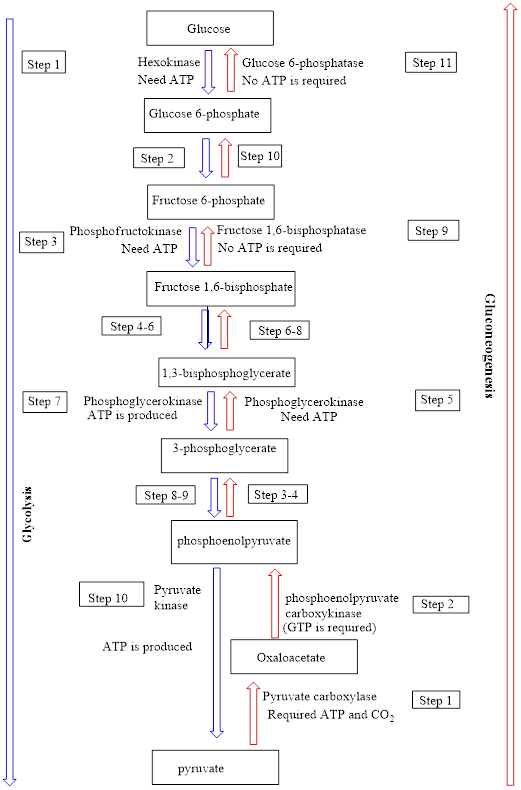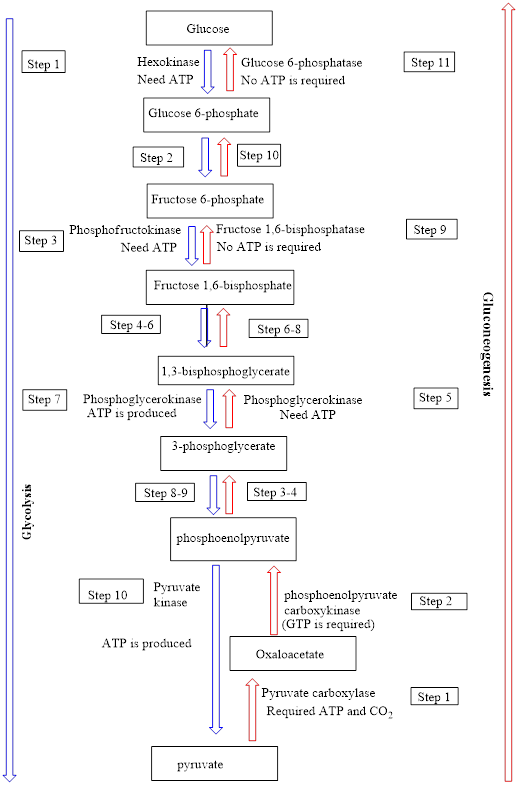
Concept explainers
(a)
Interpretation: To identify the number of “common” steps in the gluconeogenesis and glycolysis processes in which the reactants/products are the reverse of each other and the enzyme is same.
Concept introduction: Glycolysis
In the gluconeogenesis pathway, glucose is produced from non-carbohydrate substances. The net overall equation for gluconeogenesis is as follows:
An overview of the pathways of glycolysis and gluconeogenesis is as follows:

(b)
Interpretation: To identify the number of “common” steps in the gluconeogenesis and glycolysis processes in which the reactants/products are the reverse of each other and the enzyme is different.
Concept introduction: Glycolysis metabolic pathway is a ten-step enzyme catalyzed pathway in which a glucose molecule is converted to two pyruvate molecules. ATP and NADH-reduced coenzymes are produced along with pyruvate. The net overall equation for glycolysis is as follows:
In the gluconeogenesis pathway, glucose is produced from non-carbohydrate substances. The net overall equation for gluconeogenesis is as follows:
An overview of the pathways of glycolysis and gluconeogenesis is as follows:

Want to see the full answer?
Check out a sample textbook solution
Chapter 24 Solutions
General, Organic, and Biological Chemistry Seventh Edition
- What is the product of the reaction? F3C. CF3 OMe NaOH / H₂Oarrow_forwardWhat would you expect to be the major product obtained from the following reaction? Please explain what is happening here. Provide a detailed explanation and a drawing showing how the reaction occurs. The correct answer to this question is V.arrow_forwardPlease answer the question for the reactions, thank youarrow_forward
- What is the product of the following reaction? Please include a detailed explanation of what is happening in this question. Include a drawing showing how the reagent is reacting with the catalyst to produce the correct product. The correct answer is IV.arrow_forwardPlease complete the reactions, thank youarrow_forwardConsider the synthesis. What is compound Y? Please explain what is happening in this question. Provide a detailed explanation and a drawing to show how the compound Y creates the product. The correct answer is D.arrow_forward
- What would be the major product of the following reaction? Please include a detailed explanation of what is happening in this question. Include steps and a drawing to show this reaction proceeds and how the final product is formed. The correct answer is B. I put answer D and I don't really understand what is going on in the question.arrow_forwardWhat is the product of the following reaction? Please explain what is happening in this question. Provide a detailed explanation and a drawing showing how the reagent is reacting with the catalysts to product the correct product. The correct answer is B.arrow_forwardWhat is the missing intermediate 1 and the final product 2. Please include a detailed explanation explaining the steps of malonic ester synthesis. Please include drawings of the intermediate and how it occurs and how the final product is former.arrow_forward
 General, Organic, and Biological ChemistryChemistryISBN:9781285853918Author:H. Stephen StokerPublisher:Cengage Learning
General, Organic, and Biological ChemistryChemistryISBN:9781285853918Author:H. Stephen StokerPublisher:Cengage Learning Organic And Biological ChemistryChemistryISBN:9781305081079Author:STOKER, H. Stephen (howard Stephen)Publisher:Cengage Learning,
Organic And Biological ChemistryChemistryISBN:9781305081079Author:STOKER, H. Stephen (howard Stephen)Publisher:Cengage Learning, Chemistry for Today: General, Organic, and Bioche...ChemistryISBN:9781305960060Author:Spencer L. Seager, Michael R. Slabaugh, Maren S. HansenPublisher:Cengage Learning
Chemistry for Today: General, Organic, and Bioche...ChemistryISBN:9781305960060Author:Spencer L. Seager, Michael R. Slabaugh, Maren S. HansenPublisher:Cengage Learning



